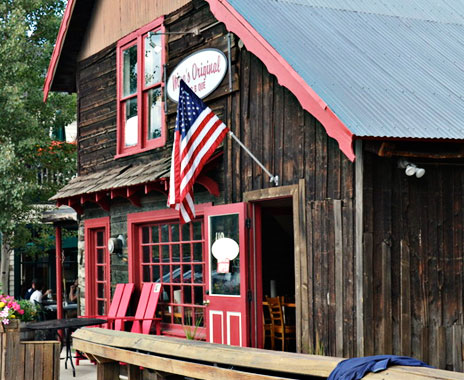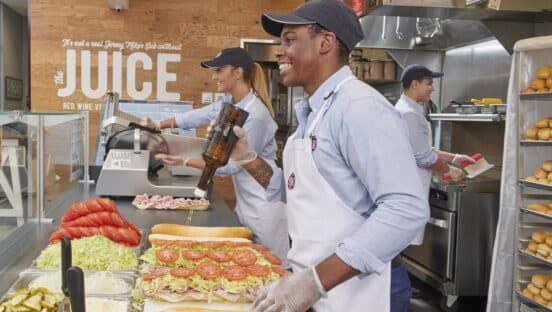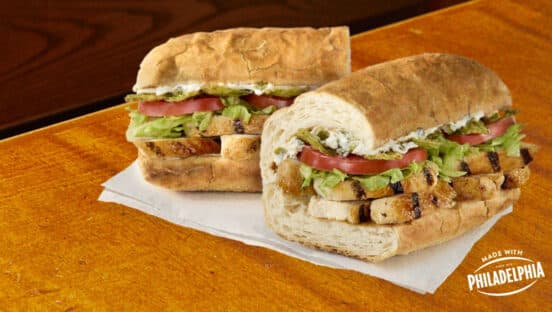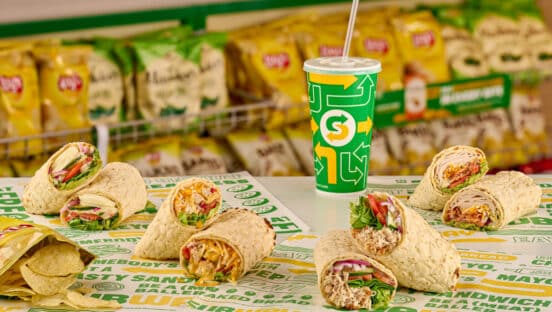Built in 1881, the log cabin housing the Moe’s Original Bar-B-Que location in Breckenridge, Colorado, has seen its fair share of action.
“As I understand it, it was the assayer’s cabin for the town,” says John Rediker, a partner at the Breckenridge unit. Precious metals extracted from the mines were brought in for weighing and valuation, keeping the area’s financial scene humming, he says.
Today, however, the cabin is seeing a new kind of action: The site complements Moe’s Southern-style barbecue with a side of rustic charm.
Constructing a suitable space for a restaurant is difficult enough, but locating inside a historic building, as several quick-serve operators all over the country have chosen to do, brings its own set of challenges.
“In a restaurant space, you need equipment … and you can’t really disturb the historic structure,” Rediker says, adding that city codes and ordinances are often stringent. “In order to find a place to bring the smoker into the building and install it in the kitchen area, we ended up having to remove an entire wall.” He says his team was able to rebuild the wall and preserve the original exterior timbers.
Four of Homegrown Sustainable Sandwich Shop’s seven locations are in historic buildings, but its newest store, in Redmond, Washington, was the first time the brand had shepherded a project through the historic preservation board’s approval process. The new unit opened in a building originally built as a bank in 1911.
“Usually it’s the real estate developer” that goes through the process, says Ben Friedman, cofounder of the Seattle-based brand. “They’ll buy an old building and fix it up.”
Though many of the utilities at the Redmond site had already been brought into the 21st century, the water and sewer connections needed to be upgraded. Working with the local municipality on the redevelopment has given Friedman new insight into what it takes to occupy an old building.
“You’re interfacing with the city even more, and in ways I think you have less leverage than ever before,” he says. Preservation boards often maintain long-term views for development and restoration of historic buildings and districts, he says, leaving foodservice brands to fit their own vision into a narrower field than is typical in other projects.
Keith Bettencourt, senior associate and retail director at BKA Architects Inc., in Brockton, Massachusetts, has been involved in a number of historic projects, including the conversion of a nearly 300-year-old Boston building into a Chipotle. He says there are several common obstacles quick serves should be ready to address when considering most old buildings. Timing is the first; permitting and design efforts are typically far more arduous than with newer structures.
“You need to figure out all the aspects of the building that aren’t standard,” he says.
Utilities are another frequent sticking point. Bettencourt stresses that old buildings weren’t designed to have modern necessities such as HVAC systems and ADA-accessible entry points. In addition, water supplies and piping may need to be upgraded.
Existing electrical utilities are also often underpowered for a restaurant’s needs. “The electrical feed ran through three different buildings,” Bettencourt says of the Boston Chipotle project. Panels and meters were distributed in other structures, making the proper clearances for maintenance and code compliance more difficult.
Of course, there’s also the buildings’ wear and tear to think about. The bottom of the walls at Moe’s were rotting due to an outdated foundation and simple neglect. “Before we could open, we had to put new foundations on the sides of our structure to shore up the building, as well as to protect against water intrusion and things of that nature,” Rediker says.
Bettencourt says quick serves moving into historic structures also need to exercise some creativity with their branding. For the Chipotle project, the team picked only certain spots to do branding in order to preserve as much of the building’s original character as possible while also complying with code requirements.
He says operators often must be willing to make compromises in their branding plans. “There are certain times where brand standards just won’t work,” he says. “The design goal was to blend the existing architecture with the Chipotle feel.”
Rediker says Moe’s branding efforts dovetailed into the historic cabin naturally. “A log cabin and a barbecue joint go hand in hand,” he says. “I think it’s a really good vibe.” The town of Breckenridge has a robust heritage, he adds, with historic walking tours and gold-mine hikes being popular activities for tourists. “This is an old Colorado mining town, and the style of our building fits very well with the downtown area.”
For Homegrown Sustainable Sandwich Shop, the Redmond building has the sort of character and authenticity the concept looks for in a space, Friedman says.
“Our aesthetic fits well with historic buildings because they have this rustic, industrial, chic vibe,” he says.
Though historic buildings require more time and financial outlay, he says, it’s well worth the investment. “We get a lot of value out of being in that beautiful space, and people perceive value in the brand because we spent the energy and time to rehabilitate and restore something special in their backyard.”









